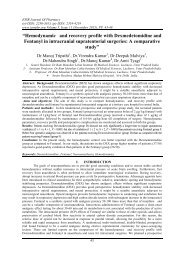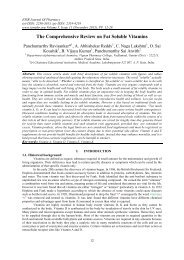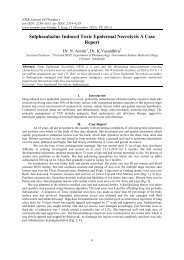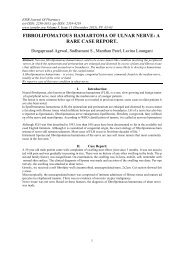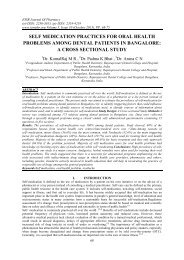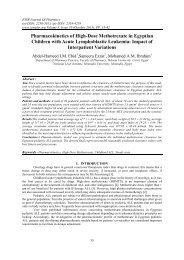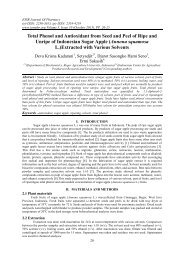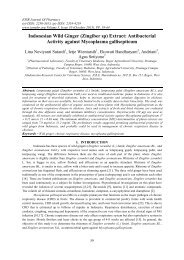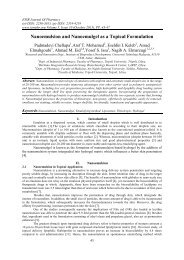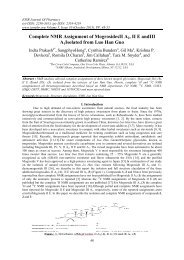Correlation of Estrogen and Progesterone Receptor expression in Breast Cancer
The IOSR Journal of Pharmacy (IOSRPHR) is an open access online & offline peer reviewed international journal, which publishes innovative research papers, reviews, mini-reviews, short communications and notes dealing with Pharmaceutical Sciences( Pharmaceutical Technology, Pharmaceutics, Biopharmaceutics, Pharmacokinetics, Pharmaceutical/Medicinal Chemistry, Computational Chemistry and Molecular Drug Design, Pharmacognosy & Phytochemistry, Pharmacology, Pharmaceutical Analysis, Pharmacy Practice, Clinical and Hospital Pharmacy, Cell Biology, Genomics and Proteomics, Pharmacogenomics, Bioinformatics and Biotechnology of Pharmaceutical Interest........more details on Aim & Scope).
The IOSR Journal of Pharmacy (IOSRPHR) is an open access online & offline peer reviewed international journal, which publishes innovative research papers, reviews, mini-reviews, short communications and notes dealing with Pharmaceutical Sciences( Pharmaceutical Technology, Pharmaceutics, Biopharmaceutics, Pharmacokinetics, Pharmaceutical/Medicinal Chemistry, Computational Chemistry and Molecular Drug Design, Pharmacognosy & Phytochemistry, Pharmacology, Pharmaceutical Analysis, Pharmacy Practice, Clinical and Hospital Pharmacy, Cell Biology, Genomics and Proteomics, Pharmacogenomics, Bioinformatics and Biotechnology of Pharmaceutical Interest........more details on Aim & Scope).
Create successful ePaper yourself
Turn your PDF publications into a flip-book with our unique Google optimized e-Paper software.
IOSR Journal Of Pharmacy<br />
(e)-ISSN: 2250-3013, (p)-ISSN: 2319-4219<br />
www.iosrphr.org Volume 5, Issue 11 (November 2015), PP. 39-42<br />
<strong>Correlation</strong> <strong>of</strong> <strong>Estrogen</strong> <strong>and</strong> <strong>Progesterone</strong> <strong>Receptor</strong> <strong>expression</strong> <strong>in</strong><br />
<strong>Breast</strong> <strong>Cancer</strong><br />
V<strong>in</strong>ita Trivedi, Ranjit Kumar*, Rita Rani, Anita Kumari, Richa Chauhan,<br />
Arun Kumar, <strong>and</strong> Md Ali<br />
Mahavir <strong>Cancer</strong> Institute & Research Centre, Phulwarisharif, Patna (Bihar), India<br />
V<strong>in</strong>ita Trivedi: Head, Dept. <strong>of</strong> Radiation Oncology, Mahavir <strong>Cancer</strong> Institute & Research Centre<br />
Rita Rani: Consultant, Dept. <strong>of</strong> Radiation Oncology, Mahavir <strong>Cancer</strong> Institute & Research Centre<br />
Anita Kumari: Consultant, Dept. <strong>of</strong> Radiation Oncology, Mahavir <strong>Cancer</strong> Institute & Research Centre<br />
Richa Chauhan: Consultant, Dept. <strong>of</strong> Radiation Oncology, Mahavir <strong>Cancer</strong> Institute & Research Centre<br />
Arun Kumar: Scientist, Research Centre, Mahavir <strong>Cancer</strong> Institute & Research Centre<br />
Md Ali: Scientist, Research Centre, Mahavir <strong>Cancer</strong> Institute & Research Centre<br />
ABSTRACT: - <strong>Breast</strong> cancer is the most common malignant tumor among women. It accounts for 22% <strong>of</strong> all<br />
female cancers; more than twice the prevalence <strong>of</strong> cancer <strong>in</strong> women at any other site. Immunohistochemistry<br />
(IHC) is now the globally accepted methodology for detection <strong>of</strong> estrogen (ER) <strong>and</strong> progesterone (PR) receptors<br />
<strong>in</strong> breast carc<strong>in</strong>omas. The present study is designed for further <strong>in</strong>sight <strong>in</strong>to age <strong>and</strong> biology <strong>of</strong> ER <strong>and</strong> PR<br />
<strong>expression</strong> pattern <strong>in</strong> breast cancer patient <strong>of</strong> Bihar, India. Samples were obta<strong>in</strong>ed from biopsy <strong>and</strong> analyzed for<br />
ER/PR <strong>expression</strong> through Immunohistochemistry (IHC). Data were collected <strong>and</strong> statistically analyzed. It was<br />
observed that mean age <strong>of</strong> ER+ positive breast cancer patients were 47 years, while mean age <strong>of</strong> PR positive<br />
patient were 44 years. Two third patients had either ER or PR is positive while one third had both negative. In<br />
our study we observed 6.4 % patients with ER negative <strong>and</strong> PR positive. Thus it is concluded that two third <strong>of</strong><br />
breast cancer patients was positive for hormone receptor. ER/PR positive <strong>in</strong>dicates over-<strong>expression</strong> <strong>of</strong> estrogen<br />
<strong>and</strong> progesterone <strong>in</strong> carc<strong>in</strong>oma breast. ER negative <strong>and</strong> PR positive group was also observed <strong>in</strong> significant<br />
number <strong>of</strong> breast cancer patients. ER negative were observed <strong>in</strong> early age group <strong>of</strong> breast cancer while PR<br />
negative were observed <strong>in</strong> higher age group patients.<br />
Key Words: Immunohistochemistry, Carc<strong>in</strong>oma, ER, PR.<br />
I. INTRODUCTION<br />
<strong>Breast</strong> cancer is the most common malignant tumor among women. It accounts for 22% <strong>of</strong> all female<br />
cancers; more than twice the prevalence <strong>of</strong> cancer <strong>in</strong> women at any other site 1 . It has a varied spectrum <strong>of</strong><br />
molecular, pathological <strong>and</strong> cl<strong>in</strong>ical features with different prognostic <strong>and</strong> therapeutic implications 2 .<br />
Invasive breast cancer is still the most common female malignancy worldwide <strong>and</strong> more than 1 million women<br />
are diagnosed with breast cancer each year 3 . Currently, it is believed that the <strong>in</strong>vasive carc<strong>in</strong>oma derives from<br />
an <strong>in</strong> situ component; because <strong>of</strong> its frequent coexistence <strong>and</strong> histological similarity 4 . This l<strong>in</strong>ear process would<br />
occur through several steps, where the normal epithelium modifies to Ductal Carc<strong>in</strong>oma <strong>in</strong> situ (DCIS),<br />
progress<strong>in</strong>g to <strong>in</strong>vasive carc<strong>in</strong>oma <strong>and</strong> then metastasis 5 .<br />
Immunohistochemistry (IHC) is now the globally accepted methodology for detection <strong>of</strong> estrogen (ER) <strong>and</strong><br />
progesterone (PR) receptors <strong>in</strong> breast carc<strong>in</strong>omas 6 . Both ER <strong>and</strong> PR show nuclear <strong>expression</strong> <strong>in</strong> positive cases.<br />
ER content, <strong>in</strong> particular, is correlated with prolonged disease-free survival <strong>and</strong> <strong>in</strong>creased likelihood <strong>of</strong> response<br />
to hormonal therapy.<br />
<strong>Estrogen</strong> <strong>and</strong> its receptor (ER) play important roles <strong>in</strong> the genesis <strong>and</strong> malignant progression <strong>of</strong> breast<br />
cancer. ERα regulates the transcription <strong>of</strong> various genes as a transcription factor, which b<strong>in</strong>ds to estrogen<br />
response elements (ERE) upstream <strong>of</strong> the target genes. The <strong>expression</strong> <strong>of</strong> ERα is closely associated with breast<br />
cancer.<br />
Thus, despite the fact that ER <strong>and</strong> PR evaluation have played central roles <strong>in</strong> breast cancer diagnostics <strong>and</strong><br />
research s<strong>in</strong>ce the 1970s, it is currently not well established if the jo<strong>in</strong>t assessment <strong>of</strong> ER <strong>and</strong> PR stratifies breast<br />
cancers <strong>in</strong>to four biologically mean<strong>in</strong>gful <strong>and</strong> cl<strong>in</strong>ically useful subgroups (ER+/PR+, ER+/PR-, ER-/PR-, <strong>and</strong><br />
ER-/PR+).<br />
The present study is designed for further <strong>in</strong>sight <strong>in</strong>to age <strong>and</strong> biology <strong>of</strong> ER <strong>and</strong> PR <strong>expression</strong> pattern <strong>in</strong> breast<br />
cancer patient <strong>of</strong> Bihar, India.<br />
39
<strong>Correlation</strong> <strong>of</strong> <strong>Estrogen</strong> <strong>and</strong> <strong>Progesterone</strong> <strong>Receptor</strong> <strong>expression</strong> <strong>in</strong> <strong>Breast</strong> <strong>Cancer</strong><br />
II. METHODS<br />
The study has been carried out on 350 breast cancer patients diagnosed <strong>and</strong> treated at Mahavir <strong>Cancer</strong><br />
Institute <strong>and</strong> Research Centre <strong>and</strong> were classified accord<strong>in</strong>g to their ER/PR <strong>expression</strong>. The study was approved<br />
by the ethics committee <strong>of</strong> Mahavir <strong>Cancer</strong> Institute <strong>and</strong> Research Centre, Patna, Bihar, India. All the patients<br />
were <strong>in</strong>volved voluntarily <strong>in</strong> this study. The IHC assays for ER <strong>and</strong> PR were performed on 3 μm sections<br />
unsta<strong>in</strong>ed slide from paraff<strong>in</strong> block <strong>and</strong> float mounted on plus-coated glass slides. The methodology for ER <strong>and</strong><br />
PR were same as for each antibody <strong>and</strong> each batch, positive <strong>and</strong> negative controls were used. Human endocervix<br />
was used as a positive control because <strong>of</strong> its easy availability <strong>and</strong> relatively stable reactivity. The negative<br />
control consisted <strong>of</strong> non-immune mouse IgG substituted for the primary antibody.<br />
Samples were obta<strong>in</strong>ed from biopsy <strong>and</strong> analyzed for ER/PR <strong>expression</strong> through Immunohistochemistry (IHC).<br />
Data were collected <strong>and</strong> statistically analysis was performed accord<strong>in</strong>g to statistical package <strong>of</strong> Graph pad<br />
Prism. The blood group frequencies were compared us<strong>in</strong>g Chi- square test. Power <strong>of</strong> study was 80% while<br />
confidence Interval (CI) was 95%.<br />
III. RESULTS<br />
It was observed that mean age <strong>of</strong> ER+ positive breast cancer patients were 47 years, while mean age <strong>of</strong><br />
PR positive patient were 44 years (Graph -I). ER was positive <strong>in</strong> 60.1% patients while ER is negative <strong>in</strong> 39.9%<br />
patients. PR is positive <strong>in</strong> 55.67 % while PR was negative <strong>in</strong> 44.33% patients. Two third patients had either ER<br />
or PR is positive while one third had both negative. In our study we observed 6.4 % patients with ER negative<br />
<strong>and</strong> PR positive (Graph –II, Table - 1).<br />
IV. DISCUSSIONS<br />
The biologic, prognostic <strong>and</strong> predictive importance <strong>of</strong> assessment <strong>of</strong> estrogen receptor (ER) <strong>expression</strong><br />
<strong>in</strong> breast cancer is well established; however, the added value <strong>of</strong> progesterone receptor (PR) assessment is<br />
controversial 7, 8 . S<strong>in</strong>ce the 1970s, it has been hypothesized that PR <strong>expression</strong> is associated with response to<br />
hormonal therapies <strong>in</strong> ER+ breast cancer, as it is thought that ER <strong>and</strong> PR co-<strong>expression</strong> demonstrates a<br />
functionally <strong>in</strong>tact estrogen response pathway 9, 10 . Analyses from observational studies showed that loss <strong>of</strong> PR<br />
<strong>expression</strong> was associated with worse overall prognosis among ER+ breast cancers 11, 12, 13, 14, 15 .<br />
These results suggested that evaluation <strong>of</strong> PR status <strong>in</strong> ER+ breast cancer might be used to help guide cl<strong>in</strong>ical<br />
management, as high levels <strong>of</strong> PR <strong>expression</strong> may identify a subset <strong>of</strong> ER+ patients most likely to benefit from<br />
hormonal therapy 16 .<br />
The presence <strong>of</strong> ER, as detected by IHC, is a weak prognostic marker <strong>of</strong> cl<strong>in</strong>ical outcome <strong>in</strong> breast cancer 17 but<br />
a strong predictive marker for response 18 to tamoxifen-based therapy. Recent studies have demonstrated that ER<br />
<strong>expression</strong> is present <strong>in</strong> approximately 70% <strong>of</strong> breast cancers, 19 so an accurate <strong>and</strong> reliable ER result is critical<br />
for hormone therapy.<br />
One <strong>of</strong> the <strong>in</strong>terest<strong>in</strong>g results <strong>in</strong> our study observed was that ER-/PR+ was found only <strong>in</strong> one case out <strong>of</strong> 137<br />
malignant cases. Such f<strong>in</strong>d<strong>in</strong>gs were also reported by Olivotto, et al., 20 as they found only one case out <strong>of</strong> 192<br />
with ER- have PR+ with weak positive immune-sta<strong>in</strong><strong>in</strong>g. These results were strongly challenged by 21 Colomer,<br />
et al., reported ER+/PR+, ER+/PR–, ER–/PR+, <strong>and</strong> ER–/PR– <strong>in</strong> 46%, 19%, 7% <strong>and</strong> 28%, respectively.<br />
In the present study we also observed 6.4% cases <strong>of</strong> ER-ve <strong>and</strong> PR+ve group, which <strong>in</strong>dicates that this group is<br />
also a important subtypes <strong>of</strong> breast cancer patients.<br />
It has further been suggested that PR status is <strong>in</strong>dependently associated with disease-free <strong>and</strong> overall survival,<br />
that is, patients with ER-positive/PR-positive tumors have a better prognosis than patients with ER-positive/PRnegative<br />
tumors, who <strong>in</strong> turn have a better prognosis than patients with ER-negative/PR-negative tumors. 22<br />
Thus it is concluded that two third <strong>of</strong> breast cancer patients were positive for hormone receptor. ER/PR positive<br />
<strong>in</strong>dicates over-<strong>expression</strong> <strong>of</strong> estrogen <strong>and</strong> progesterone <strong>in</strong> carc<strong>in</strong>oma breast. ER negative <strong>and</strong> PR positive group<br />
were also observed <strong>in</strong> significant number <strong>of</strong> breast cancer patients. ER negative was observed <strong>in</strong> early age group<br />
<strong>of</strong> breast cancer while PR negative were observed <strong>in</strong> higher age group patients.<br />
V. ACKNOWLEDGEMENT<br />
The authors are thankful to all faculties <strong>and</strong> staff <strong>of</strong> Mahavir <strong>Cancer</strong> Institute <strong>and</strong> Research Centre, Patna for<br />
their proper support dur<strong>in</strong>g this study.<br />
REFERENCES<br />
[1]. Lal P, Chen B. <strong>Correlation</strong> <strong>of</strong> HER-2 status with estrogen <strong>and</strong> progesterone receptors <strong>and</strong> histological<br />
features <strong>in</strong> 3,655 <strong>in</strong>vasive breast cancers. American Journal <strong>of</strong> Cl<strong>in</strong>ical Pathology, 2005, 123 (4): 541-6,<br />
[2]. Carey L A, Perou C M, Livasy C A,et al. Race breast cancer subtypes <strong>and</strong> survival <strong>in</strong> the Carol<strong>in</strong>a breast<br />
cancer study. JAMA, 2006, 295: 2492- 502,<br />
[3]. Park<strong>in</strong> DM, Bray F, Ferlay J, Pisani P. Global cancer statistics-2002. CA <strong>Cancer</strong> J Cl<strong>in</strong> 2005; 55: 74-108.<br />
40
<strong>Correlation</strong> <strong>of</strong> <strong>Estrogen</strong> <strong>and</strong> <strong>Progesterone</strong> <strong>Receptor</strong> <strong>expression</strong> <strong>in</strong> <strong>Breast</strong> <strong>Cancer</strong><br />
[4]. Allred DC, Wu Y, Mao S, et al. Ductal carc<strong>in</strong>oma <strong>in</strong> situ <strong>and</strong> the emergence <strong>of</strong> diversity dur<strong>in</strong>g breast<br />
cancer evolution. Cl<strong>in</strong> <strong>Cancer</strong> Res 2008; 14: 370-8.<br />
[5]. Mario CS, Jose´ LP, Ricardo FS, Cla´udio GZ. Are the pure <strong>in</strong> situ breast ductal carc<strong>in</strong>omas <strong>and</strong> those<br />
associated with <strong>in</strong>vasive carc<strong>in</strong>oma the same?. Appl Immunohistochem Mol Morphol 2010; 18:51-4.<br />
[6]. Harvey JM, Clark CM, Osborne CK, Allred DC. <strong>Estrogen</strong> receptor status by immunohistochemistry is<br />
superior to the lig<strong>and</strong>-b<strong>in</strong>d<strong>in</strong>g assay for predict<strong>in</strong>g response to adjuvant endocr<strong>in</strong>e therapy <strong>in</strong> breast<br />
cancer. J Cl<strong>in</strong> Oncol. 1999. 17: 1474 – 1481.<br />
[7]. Colozza M, Larsimont D, Piccart MJ: <strong>Progesterone</strong> receptor test<strong>in</strong>g: not the right time to be buried. J Cl<strong>in</strong><br />
Oncol 2005, 23:3867–3868.<br />
[8]. Fuqua SA, Cui Y, Lee AV, Osborne CK, Horwitz KB: Insights <strong>in</strong>to the role <strong>of</strong> progesterone receptors <strong>in</strong><br />
breast cancer. J Cl<strong>in</strong> Oncol 2005, 23:931–932.<br />
[9]. Horwitz KB, McGuire W: <strong>Estrogen</strong> control <strong>of</strong> progesterone receptor <strong>in</strong> human breast cancer, correlation<br />
with nuclear process<strong>in</strong>g <strong>of</strong> estrogen receptor. J Biol Chem 1978, 253:2223–2228.<br />
[10]. Horwitz KB, McGuire WL: <strong>Estrogen</strong> control <strong>of</strong> progesterone receptor <strong>in</strong>duction <strong>in</strong> human breast cancer:<br />
role <strong>of</strong> nuclear estrogen receptor. Adv Exp Med Biol 1979, 117:95–110.<br />
[11]. Dunnwald LK, Ross<strong>in</strong>g MA, Li CI: Hormone receptor status, tumor characteristics, <strong>and</strong> prognosis: a<br />
prospective cohort <strong>of</strong> breast cancer patients. <strong>Breast</strong> <strong>Cancer</strong> Res 2007, 9:R6.<br />
[12]. Grann VR, Troxel AB, Zojwalla NJ, Jacobson JS, Hershman D, Neugut AI: Hormone receptor status <strong>and</strong><br />
survival <strong>in</strong> a population-based cohort <strong>of</strong> patients with breast carc<strong>in</strong>oma. <strong>Cancer</strong> 2005, 103:2241–2251.<br />
[13]. Bardou VJ, Arp<strong>in</strong>o G, Elledge RM, Osborne CK, Clark GM: <strong>Progesterone</strong> receptor status significantly<br />
improves outcome prediction over estrogen receptor status alone for adjuvant endocr<strong>in</strong>e therapy <strong>in</strong> two<br />
large breast cancer databases. J Cl<strong>in</strong> Oncol 2003, 21:1973–1979.<br />
[14]. Cancello G, Maisonneuve P, Rotmensz N, Viale G, Mastropasqua MG, Pruneri G, Montagna E, Iorfida<br />
M, Mazza M, Balduzzi A, Veronesi P, Lu<strong>in</strong>i A, Intra M, Goldhirsch A, Colleoni M: <strong>Progesterone</strong><br />
receptor loss identifies lum<strong>in</strong>al B breast cancer subgroups at higher risk <strong>of</strong> relapse. Ann Oncol 2013,<br />
24:661–668.<br />
[15]. Prat A, Cheang MC, Mart<strong>in</strong> M, Parker JS, Carrasco E, Caballero R, Tyldesley S, Gelmon K, Bernard PS,<br />
Nielsen TO, Perou CM: Prognostic significance <strong>of</strong> progesterone receptor-positive tumor cells with<strong>in</strong><br />
immunohistochemically def<strong>in</strong>ed lum<strong>in</strong>al A breast cancer. J Cl<strong>in</strong> Oncol 2013, 31:203–209.<br />
[16]. Horwitz KB, McGuire WL: Predict<strong>in</strong>g response to endocr<strong>in</strong>e therapy <strong>in</strong> human breast cancer: a<br />
hypothesis. Science 1975, 189:726–727.<br />
[17]. Hahnel R, Wood<strong>in</strong>gs T, Vivian AB. Prognostic value <strong>of</strong> estrogen receptors <strong>in</strong> primary breast cancer.<br />
<strong>Cancer</strong>. 1979; 44: 671 – 675.<br />
[18]. Allred DC, Harvey JM, Berardo M, Berardo M, Clark GM. Prognostic <strong>and</strong> predictive factors <strong>in</strong> breast<br />
cancer by immunohistochemical analysis. Mod Pathol. 1998. 11: 155 – 168.<br />
[19]. Nadji M, Gomez-Fern<strong>and</strong>ez C, Ganjei-Azar P, Morales AR. Immunohistochemistry <strong>of</strong> estrogen <strong>and</strong><br />
progesterone receptors reconsidered: experience with 5,993 breast cancers. Am J Cl<strong>in</strong> Pathol. 2005; 123:<br />
21 – 27.<br />
Table – 1: ER <strong>and</strong> PR <strong>expression</strong> <strong>and</strong> <strong>Breast</strong> <strong>Cancer</strong><br />
Positive<br />
Negative<br />
Marker Number Percent Number Percent P- Value<br />
ER 122 60.10 81 39.90 0.0003<br />
PR 113 55.67 90 44.33 0.0025<br />
41
years<br />
<strong>Correlation</strong> <strong>of</strong> <strong>Estrogen</strong> <strong>and</strong> <strong>Progesterone</strong> <strong>Receptor</strong> <strong>expression</strong> <strong>in</strong> <strong>Breast</strong> <strong>Cancer</strong><br />
Graph- I: Age <strong>of</strong> <strong>Breast</strong> cancer Patients<br />
60<br />
40<br />
20<br />
0<br />
ER+PR+<br />
ER-PR-<br />
ER+PR-<br />
ER-PR+<br />
Graph- II: ER / PR Expression <strong>in</strong> <strong>Breast</strong> cancer Patients<br />
49.26<br />
50<br />
45<br />
40<br />
35<br />
33.5<br />
30<br />
25<br />
20<br />
15<br />
10<br />
5<br />
10.84<br />
6.4<br />
0<br />
ER +ve PR +ve ER -ve PR -ve ER +ve PR -ve ER -ve PR +ve<br />
42




